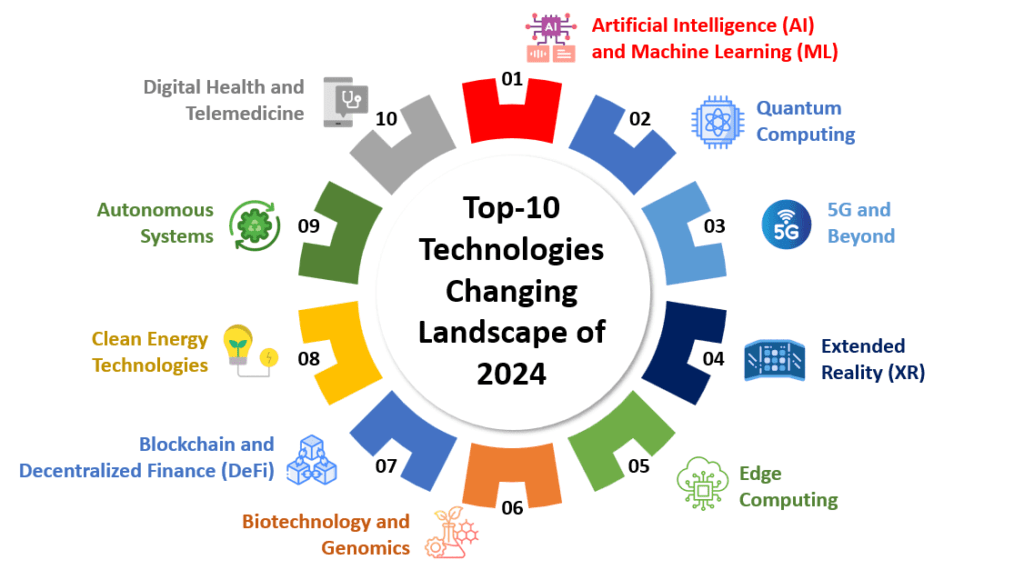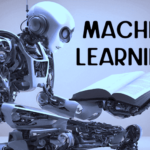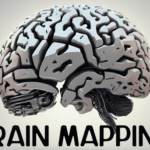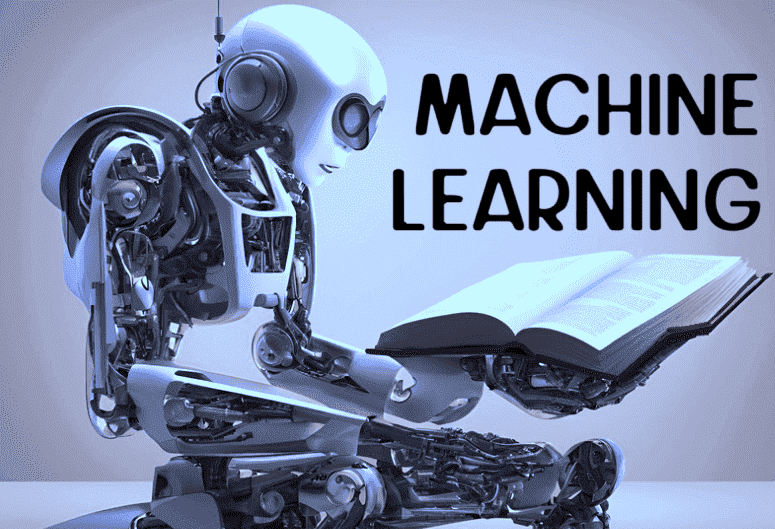
The year 2024 heralds a new epoch of technological advancement, where innovation converges with necessity to redefine the way we live, work, and interact. At the forefront of this evolution are these top 10 technologies poised to revolutionize every aspect of human endeavor. Artificial Intelligence (AI) and Machine Learning (ML) lead the charge, empowering machines with human-like intelligence and decision-making capabilities. Meanwhile, Quantum Computing stands ready to unlock unparalleled computational power, promising solutions to complex problems that were once deemed overwhelming.
Edge Computing, conversely, empowers remote devices with such advanced intelligence that they can autonomously make decisions. These technologies, alongside the imminent rollout of 5G networks and the immersive experiences offered by Extended Reality (XR), herald a future where connectivity knows no bounds and the digital realm seamlessly integrates with the physical world.
Moreover, the fusion of Biotechnology and Genomics presents unprecedented opportunities in healthcare, agriculture, and environmental sustainability, while Blockchain and Decentralized Finance (DeFi) disrupt traditional financial systems with transparent, trustless transactions. Clean Energy Technologies pave the way towards a greener future, while Autonomous Systems and Digital Health solutions revolutionize transportation and healthcare delivery, respectively. As we embark on this journey of technological transformation, understanding the potential, challenges, and ethical implications of these innovations is paramount. Join us as we delve into the dynamic landscape of emerging technologies shaping the world in 2024 and beyond.
So, let’s explore those top 10 emerging technologies shaping the landscape of 2024:
1. Artificial Intelligence (AI) and Machine Learning (ML):
AI and ML are branches of computer science focused on creating systems that can perform tasks requiring human intelligence. AI aims to simulate human cognition, while ML focuses on algorithms that improve automatically through experience.
Key Trends: Continued advancements in deep learning algorithms, AI-powered automation in various industries such as manufacturing and finance, expansion of AI applications in healthcare for diagnosis and treatment planning, increased focus on ethical AI development and responsible AI usage.
Challenges and Limitations: Concerns regarding data privacy, algorithmic bias, and the potential for job displacement due to automation.
Potential Applications: AI-driven personal assistants, predictive analytics for business decision-making, autonomous vehicles, and medical diagnosis systems.
Regulatory and Ethical Considerations: Regulatory frameworks for AI usage, ethical guidelines for AI development and deployment, addressing biases in AI algorithms.
Market Dynamics: Growing investment in AI startups, increasing adoption of AI technologies across industries, consolidation of AI market players.
Research and Development: Breakthroughs in reinforcement learning, federated learning, and AI explainability.
Partnership Ecosystem: Collaboration between tech giants, research institutions, and government agencies to advance AI research and development.
Impact on Society and Environment: Potential for job creation in AI-related fields, concerns about AI’s impact on income inequality, environmental implications of increased energy consumption by AI systems.
Future Outlook: Continued integration of AI into everyday products and services, advancements in AI ethics and regulation, exploration of new AI paradigms beyond deep learning.
2. Quantum Computing:
Quantum computing utilizes principles of quantum mechanics to process and analyze information. Unlike classical computers that use bits, which represent either 0 or 1, quantum computers use qubits, which can represent 0, 1, or both simultaneously, enabling them to perform complex computations much faster than classical computers.
Key Trends: Achieving quantum supremacy with larger and more stable qubit systems, progress in error correction and fault-tolerant quantum computing, applications in drug discovery, optimization problems, and cryptography.
Challenges and Limitations: Maintaining qubit coherence and stability, scaling quantum systems to handle practical problems, high cost and complexity of quantum hardware.
Potential Applications: Quantum simulations for material science and drug discovery, optimization of supply chains and financial portfolios, quantum-safe cryptography.
Regulatory and Ethical Considerations: Development of international standards for quantum encryption and communication, ethical considerations around quantum computing’s potential impact on data security and privacy.
Market Dynamics: Growth of quantum computing startups and research initiatives, investment from governments and private sector in quantum technology development.
Research and Development: Breakthroughs in qubit coherence and error correction, advancements in quantum algorithms and software development.
Partnership Ecosystem: Collaboration between academia, industry, and government agencies to advance quantum research and development, formation of quantum computing consortia and partnerships.
Impact on Society and Environment: Potential for breakthroughs in drug discovery and materials science, implications for cybersecurity and encryption, environmental considerations related to energy consumption of quantum hardware.
Future Outlook: Continued progress towards fault-tolerant quantum computing, exploration of quantum machine learning algorithms, integration of quantum computing into cloud platforms and enterprise solutions.
3. 5G and Beyond:
5G represents the latest generation of wireless communication technology, offering faster data speeds, lower latency, and increased device connectivity compared to previous generations. Beyond 5G, researchers are exploring even more advanced technologies to meet future connectivity demands.
Key Trends: Deployment of standalone 5G networks, development of 6G technology with even faster speeds and lower latency, integration of 5G into various industries such as smart cities, healthcare, and autonomous vehicles.
Challenges and Limitations: High infrastructure costs for deploying 5G networks, spectrum availability and allocation issues, concerns about potential health effects of electromagnetic radiation.
Potential Applications: Enhanced mobile broadband for streaming and gaming, IoT connectivity for smart homes and cities, low-latency applications like remote surgery and autonomous vehicles.
Regulatory and Ethical Considerations: Regulatory frameworks for 5G deployment and spectrum allocation, addressing concerns about privacy and surveillance with increased connectivity.
Market Dynamics: Competition among telecom operators for 5G market share, investment in 5G infrastructure and equipment by governments and private sector, growth of 5G-enabled devices and applications.
Research and Development: Innovation in 5G technology standards and protocols, exploration of new frequency bands and network architectures for 6G.
Partnership Ecosystem: Collaboration between telecom companies, equipment manufacturers, and government agencies to accelerate 5G deployment and research.
Impact on Society and Environment: Potential for economic growth and innovation with 5G-enabled technologies, concerns about digital divide and accessibility, environmental impact of increased energy consumption by 5G networks.
Future Outlook: Expansion of 5G coverage in rural and underserved areas, integration of 5G with emerging technologies like AI and IoT, early research and development efforts for 6G technology.
4. Extended Reality (XR):
Extended Reality (XR) encompasses technologies that merge the physical and digital worlds, including virtual reality (VR), augmented reality (AR), and mixed reality (MR). XR enables users to interact with digital content in real-world environments or immerse themselves in entirely virtual experiences.
Key Trends: Advancements in AR glasses and headsets for practical applications in fields like remote assistance and navigation, growth of VR for entertainment, gaming, and training simulations, emergence of new MR experiences blending physical and digital worlds seamlessly.
Challenges and Limitations: Hardware limitations such as field of view and resolution in AR and VR devices, concerns about motion sickness and eye strain, content creation challenges.
Potential Applications: AR for remote collaboration and maintenance, VR for immersive training and education, MR for interactive design and visualization.
Regulatory and Ethical Considerations: Privacy concerns with AR glasses and spatial mapping technologies, ethical implications of immersive experiences in healthcare and education.
Market Dynamics: Competition among tech giants and startups in the AR and VR market, growth of XR content creation platforms and marketplaces.
Research and Development: Innovation in display technologies for AR and VR, development of haptic feedback and gesture recognition systems, exploration of new interaction paradigms for MR.
Partnership Ecosystem: Collaboration between hardware manufacturers, software developers, and content creators to drive XR ecosystem growth.
Impact on Society and Environment: Potential for XR to revolutionize education and training, implications for entertainment and storytelling, concerns about XR addiction and social isolation.
Future Outlook: Integration of XR into everyday devices like smartphones and smart glasses, growth of location-based XR experiences, advancements in social VR and AR collaboration tools.
5. Edge Computing:
Edge computing involves processing data closer to the source of generation, reducing latency and bandwidth usage by performing computation at or near the edge of the network. This decentralized approach enables faster response times and more efficient data processing for applications ranging from IoT devices to real-time analytics.
Key Trends: Integration of edge computing with AI and IoT devices for real-time data analysis and decision-making, expansion of edge infrastructure to support edge-native applications, growth in edge computing security solutions to protect distributed systems.
Challenges and Limitations: Standardization and interoperability challenges in heterogeneous edge environments, data privacy and security concerns at the edge, resource constraints on edge devices.
Potential Applications: Real-time analytics for IoT devices, edge AI for autonomous vehicles and drones, low-latency applications like video streaming and gaming.
Regulatory and Ethical Considerations: Data sovereignty and compliance with local regulations at the edge, ethical considerations around edge AI decision-making and privacy.
Market Dynamics: Growth of edge computing platforms and solutions, competition among cloud providers and telecom companies in the edge market.
Research and Development: Innovation in edge computing architectures and protocols, development of edge-native AI algorithms and models, exploration of edge computing applications in smart cities and industrial IoT.
Partnership Ecosystem: Collaboration between cloud providers, telecom operators, and edge hardware manufacturers to build out edge infrastructure.
Impact on Society and Environment: Potential for improved efficiency and reduced latency in IoT applications, concerns about data privacy and security at the edge, environmental impact of increased edge infrastructure.
Future Outlook: Integration of edge computing with 5G networks, growth of edge AI capabilities, advancements in edge security and privacy solutions.
6. Biotechnology and Genomics:
Biotechnology involves the manipulation of living organisms or biological systems to develop products or processes for specific applications. Genomics is the study of an organism’s complete set of DNA, including its genes and their functions. Together, biotechnology and genomics drive innovations in fields such as healthcare, agriculture, and environmental sustainability.
Key Trends: Advancements in CRISPR gene editing technology for precise genome modifications, personalized medicine tailored to individual genetic profiles, synthetic biology applications for sustainable manufacturing and biofuels, development of mRNA vaccines and other biopharmaceuticals.
Challenges and Limitations: Ethical considerations around genome editing and genetic engineering, regulatory hurdles in drug development and approval, potential for misuse of biotechnology in biosecurity and bioterrorism.
Potential Applications: Precision medicine for targeted cancer therapies, genetically modified crops for improved yield and sustainability, bioengineering of microbes for environmental remediation.
Regulatory and Ethical Considerations: Regulatory frameworks for genome editing and genetically modified organisms, ethical guidelines for biotechnology research and applications, public perception and acceptance of biotechnological innovations.
Market Dynamics: Growth of biotech startups and investment in life sciences research, consolidation in the biopharmaceutical industry through mergers and acquisitions.
Research and Development: Breakthroughs in gene editing techniques and delivery methods, development of novel biologics and gene therapies, exploration of microbiome-based therapeutics.
Partnership Ecosystem: Collaboration between academia, industry, and government agencies in biotechnology research and development, formation of biotech clusters and innovation hubs.
Impact on Society and Environment: Potential for improved healthcare outcomes and personalized treatments, concerns about access to expensive biotech therapies, environmental implications of genetically modified organisms.
Future Outlook: Expansion of gene editing applications beyond healthcare, growth of synthetic biology as a platform for bio-based manufacturing, advancements in gene therapy and regenerative medicine.
7. Blockchain and Decentralized Finance (DeFi):
Blockchain is a distributed ledger technology that enables secure and transparent recording of transactions across multiple parties. Decentralized Finance (DeFi) refers to a movement that aims to recreate traditional financial services using blockchain technology, eliminating the need for intermediaries like banks.
Key Trends: Continued development of more scalable and energy-efficient blockchain protocols, growth of decentralized finance (DeFi) platforms for lending, borrowing, and trading digital assets, real-world applications of smart contracts in supply chain management and digital identity verification.
Challenges and Limitations: Scalability issues with existing blockchain networks, regulatory uncertainty around cryptocurrencies and DeFi platforms, concerns about energy consumption and environmental impact of proof-of-work consensus mechanisms.
Potential Applications: Transparent and tamper-proof supply chain tracking using blockchain, decentralized identity management for secure digital identity verification, tokenization of assets for fractional ownership and liquidity.
Regulatory and Ethical Considerations: Regulatory frameworks for cryptocurrencies and token offerings, concerns about money laundering and illicit activities in decentralized finance, ethical considerations around blockchain governance and consensus mechanisms.
Market Dynamics: Growth of cryptocurrency markets and trading platforms, emergence of decentralized exchanges and lending protocols, investment in blockchain infrastructure and enterprise blockchain solutions.
Research and Development: Innovation in blockchain scalability solutions such as sharding and layer 2 protocols, development of privacy-preserving and energy-efficient consensus mechanisms, exploration of blockchain interoperability standards.
Partnership Ecosystem: Collaboration between blockchain startups, financial institutions, and regulatory bodies to address compliance and regulatory challenges, formation of industry consortia to develop blockchain standards and best practices.
Impact on Society and Environment: Potential for financial inclusion and access to banking services in underserved regions through DeFi, concerns about volatility and speculation in cryptocurrency markets, environmental implications of energy-intensive blockchain mining.
Future Outlook: Integration of blockchain with Internet of Things (IoT) devices for secure data exchange, growth of decentralized governance models and DAOs (Decentralized Autonomous Organizations), exploration of blockchain-based solutions for climate change mitigation and sustainability.
8. Clean Energy Technologies:
Clean energy technologies focus on generating electricity from renewable sources like solar, wind, and hydro power, as well as developing energy storage and carbon capture solutions to mitigate climate change. These technologies aim to reduce dependence on fossil fuels and minimize environmental impact.
Key Trends: Advancements in solar panel efficiency and cost reduction, growth of offshore wind farms and floating solar installations, development of grid-scale energy storage systems using batteries and hydrogen, innovation in carbon capture and utilization technologies to reduce greenhouse gas emissions.
Challenges and Limitations: Intermittency and variability of renewable energy sources, grid integration challenges, high upfront costs of clean energy infrastructure, public resistance to renewable energy projects.
Potential Applications: Renewable energy microgrids for remote communities, energy storage solutions for grid stabilization, carbon capture and utilization for industrial emissions reduction.
Regulatory and Ethical Considerations: Regulatory frameworks for renewable energy deployment and grid integration, ethical considerations around energy access and equity, environmental justice in siting renewable energy projects.
Market Dynamics: Growth of renewable energy markets and investment in clean energy projects, increasing competitiveness of renewable energy technologies compared to fossil fuels.
Research and Development: Breakthroughs in next-generation solar cells and wind turbine technologies, advancements in energy storage materials and systems, exploration of new carbon capture methods and utilization pathways.
Partnership Ecosystem: Collaboration between governments, research institutions, and private sector companies to accelerate clean energy innovation and deployment, formation of international alliances for renewable energy development and climate action.
Impact on Society and Environment: Potential for job creation in the clean energy sector, improvements in air quality and public health, contributions to climate change mitigation and adaptation.
Future Outlook: Continued cost reductions and scalability of renewable energy technologies, growth of renewable energy markets in developing countries, exploration of renewable energy-based solutions for sustainable development.
9. Autonomous Systems:
Autonomous systems leverage artificial intelligence and sensor technologies to perform tasks without human intervention. This includes self-driving cars, drones, robots, and other devices capable of making decisions and taking actions based on their environment.
Key Trends: Increasing autonomy in vehicles with advancements in sensor fusion and perception algorithms, expansion of drone applications in delivery, agriculture, and surveillance, adoption of collaborative robots (cobots) in manufacturing and logistics for human-robot collaboration.
Challenges and Limitations: Safety and reliability concerns with autonomous vehicle technology, regulatory hurdles for autonomous systems in public spaces, ethical considerations around AI-driven decision-making in autonomous systems.
Potential Applications: Autonomous vehicles for transportation and logistics, drones for aerial mapping and surveillance, robotic automation for repetitive tasks in manufacturing and healthcare.
Regulatory and Ethical Considerations: Regulatory frameworks for autonomous vehicles and drones, ethical guidelines for AI-driven decision-making in autonomous systems, liability issues in the event of accidents or failures.
Market Dynamics: Growth of autonomous vehicle markets and investment in self-driving technology, increasing adoption of drones for commercial applications, expansion of collaborative robot markets in manufacturing and logistics.
Research and Development: Innovation in sensor technologies for perception and navigation, development of AI algorithms for real-time decision-making in dynamic environments, exploration of human-robot interaction and collaboration.
Partnership Ecosystem: Collaboration between automotive manufacturers, technology companies, and regulatory agencies to advance autonomous vehicle technology, partnerships between drone companies and industries like agriculture and construction.
Impact on Society and Environment: Potential for improved road safety and traffic efficiency with autonomous vehicles, contributions to precision agriculture and environmental monitoring with drones, concerns about job displacement in industries affected by automation.
Future Outlook: Integration of autonomous systems into smart city infrastructure, advancements in AI-driven robotics for complex tasks, exploration of ethical frameworks for autonomous decision-making in healthcare and other critical domains.
10. Digital Health and Telemedicine:
Digital health encompasses a wide range of technologies and services aimed at improving healthcare delivery, patient outcomes, and access to medical services. Telemedicine, a subset of digital health, involves providing healthcare services remotely using telecommunications technology, allowing patients to consult with healthcare providers without physically visiting a clinic or hospital.
Key Trends: Expansion of telehealth services for remote consultations and monitoring, growth of wearable health devices for continuous health monitoring, adoption of AI-driven diagnostics and predictive analytics for disease detection and treatment planning, integration of electronic health records (EHR) and interoperability standards for seamless data exchange between healthcare providers.
Challenges and Limitations: Regulatory barriers to telemedicine adoption, concerns about data privacy and security in digital health systems, disparities in access to technology and digital health services.
Potential Applications: Telemedicine for remote diagnosis and treatment, wearable devices for chronic disease management and preventive care, AI-driven decision support systems for healthcare providers.
Regulatory and Ethical Considerations: Regulatory frameworks for telemedicine and digital health technologies, ethical guidelines for AI-driven healthcare decision-making, patient consent and data ownership in digital health systems.
Market Dynamics: Growth of telemedicine platforms and virtual care providers, increasing adoption of wearable health devices by consumers and healthcare providers, investment in digital health startups and technology development.
Research and Development: Innovation in remote patient monitoring technologies and sensors, development of AI algorithms for medical imaging and diagnostics, exploration of blockchain for secure health data exchange.
Partnership Ecosystem: Collaboration between healthcare providers, technology companies, and regulatory agencies to advance digital health adoption, partnerships between telemedicine platforms and insurance companies.
Impact on Society and Environment: Potential for improved access to healthcare services in underserved regions, reduction in healthcare costs and hospital readmissions with remote monitoring, concerns about data security and patient privacy in digital health systems.
Future Outlook: Integration of AI-driven chatbots and virtual assistants into telemedicine platforms, growth of remote patient monitoring for chronic disease management, exploration of digital therapeutics and prescription apps for mental health and chronic conditions.












7 thoughts on “Revealing the Top 10 Emerging Technologies Reshaping 2024”